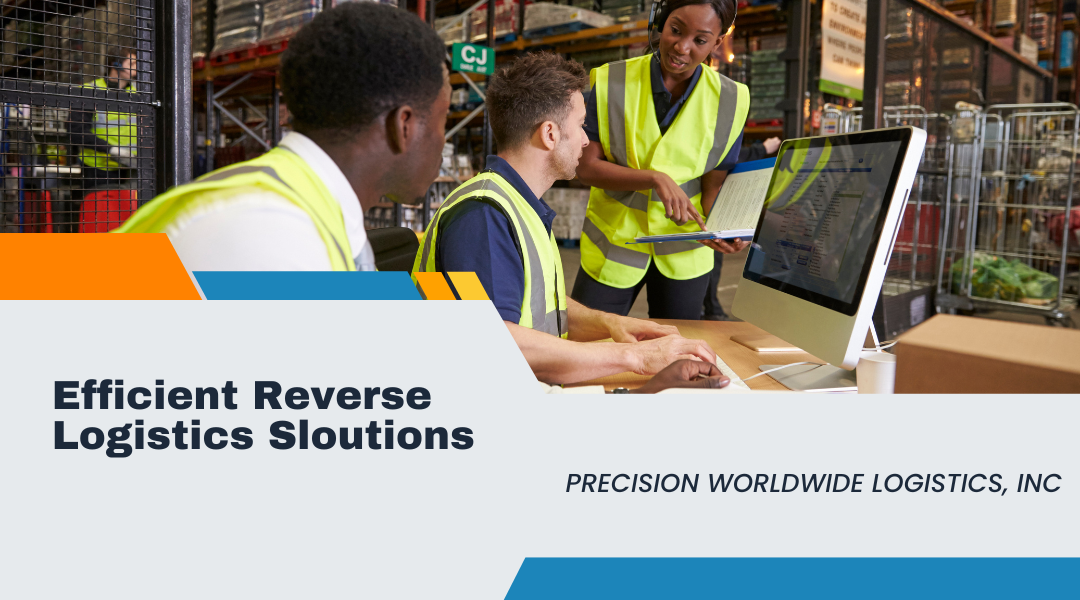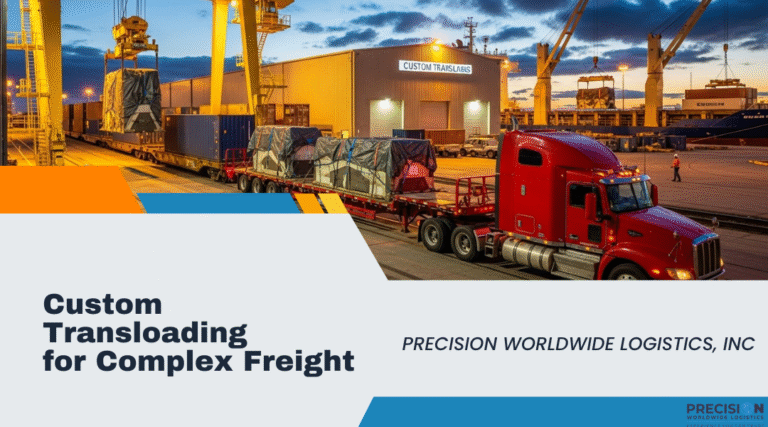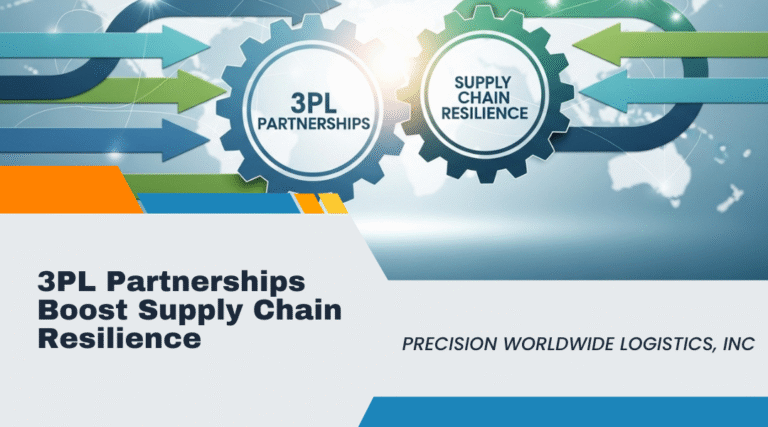Returns management plays a crucial role in the efficiency of reverse logistics, directly impacting cost control and customer satisfaction. Precision Worldwide Logistics, Inc. understands that handling returns smoothly is essential for maintaining a streamlined supply chain and reducing unnecessary expenses. Effective reverse logistics involves coordinating the movement of returned goods, ensuring they are processed quickly and accurately to optimize inventory recovery or disposal.
With its comprehensive logistics services based in La Mirada, California, Precision Worldwide Logistics offers tailored solutions that address the complexities of returns management. By integrating warehousing, transportation, and transloading capabilities, the company provides businesses with a reliable way to manage returned products without disrupting their operations. This approach helps companies save time and resources while enhancing overall supply chain resilience.
What Is Reverse Logistics and Why It Matters
Reverse logistics involves managing the flow of products moving backward through the supply chain, from the consumer to the origin. This process affects product returns, repairs, recycling, and the overall efficiency of supply chains.
Proper handling of reverse logistics directly influences operational costs, inventory accuracy, and customer satisfaction. Companies that optimize these activities can reduce waste and improve service quality.
Definition and Core Functions of Reverse Logistics
Reverse logistics is the movement of goods from customers back to manufacturers, retailers, or disposal points. Unlike traditional logistics, which focuses on delivering products, reverse logistics handles returns, repairs, refurbishments, and recycling.
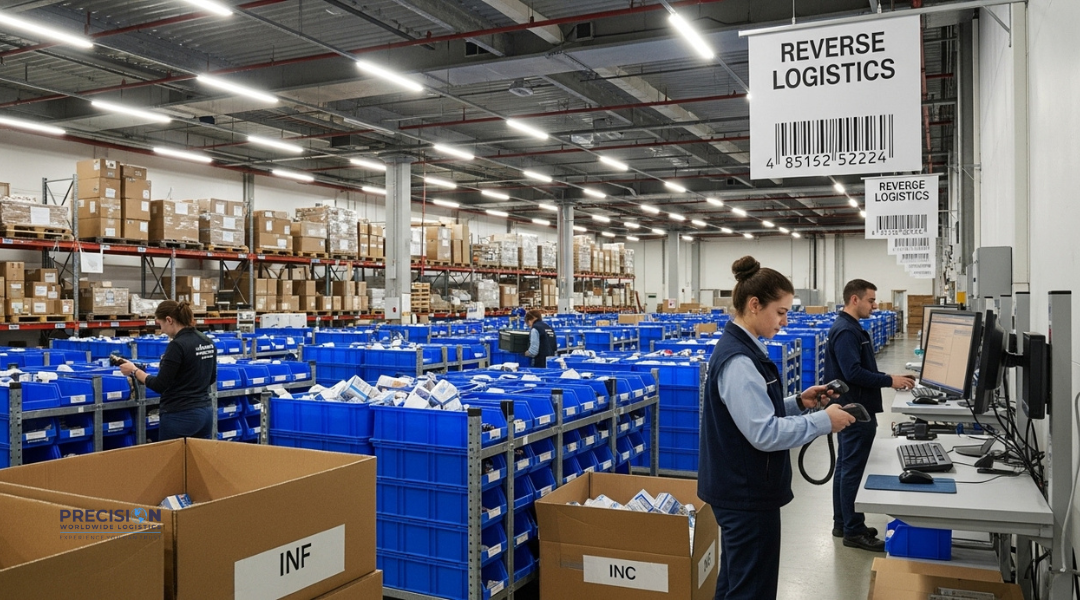
Its core functions include processing returned products, inspecting their condition, deciding whether to restock, repair, or recycle, and managing transportation back through the supply chain.
An efficient reverse logistics process minimizes delays and maximizes the recovery of value from returned goods while complying with environmental regulations.
How Returns Impact the Overall Supply Chain
Returns create additional demands on storage, transportation, and administrative resources. They require dedicated handling facilities and specialized processes to sort and evaluate returned items.
Returns can disrupt normal inventory flows if not managed properly, leading to stock imbalances or shortages. They also influence warehouse space utilization and shipping schedules.
An integrated reverse logistics system helps maintain supply chain balance by swiftly moving products through return channels and minimizing disruptions to forward logistics operations.
The Cost and Customer Experience Connection
Handling returns improperly can raise operational costs dramatically due to extra transportation, inspection, and processing. These costs reduce profit margins and waste valuable resources.
Customer satisfaction depends heavily on return policies and the speed of reverse logistics. Clear communication and fast processing encourage repeat business and positive reviews.
Investing in reverse logistics improvements helps companies reduce costs and improve service quality, creating a competitive advantage in markets where efficient returns are critical.
Common Challenges in Returns Management
Returns management involves handling large volumes of products, tracking shipments precisely, and maintaining clear policies to meet customer expectations. These key areas often present difficulties that affect efficiency and customer satisfaction.
High Return Volumes and Processing Delays
Many companies face significant challenges from increased return volumes, especially during peak seasons. High return rates strain resources, requiring more labor for inspection, sorting, and restocking.
Processing delays often happen because facilities are not equipped to handle the sudden surge. Lack of automation and inefficient workflows slow down the turnaround time, increasing operational costs and delaying revenue recovery.
To manage this, businesses must optimize space, staff allocation, and develop streamlined procedures that scale with return demand. Clear scheduling and prioritization of returns can also reduce bottlenecks.
Lack of Visibility and Tracking for Return Shipments
Insufficient tracking systems create difficulties in monitoring the status of returned goods throughout the reverse logistics process. This lack of visibility leads to misplaced shipments, inaccurate inventory records, and slower problem resolution.
Real-time tracking and improved communication between carriers, warehouses, and customers are vital to reduce uncertainty. Transparency allows quicker handling decisions and reduces disputes over lost or delayed returns.
Integration of advanced technology, such as barcode scanning and IoT devices, helps maintain accurate, up-to-date data on returns as products move back through the supply chain.
Inconsistent Return Policies and Customer Frustration
Varying return policies across channels or unclear guidelines can confuse customers and result in poor experiences. Inconsistent rules about timeframes, product conditions, and refund types often lead to disputes and dissatisfaction.
Customers expect straightforward and standardized processes. Failure to deliver clear instructions or communicate changes negatively impacts brand trust and loyalty.
Companies must establish simple, consistent return policies that are easy to understand and enforce. Clear communication at the point of sale and online reduces frustration and encourages repeat business.
Key Components of an Efficient Reverse Logistics Strategy
An effective reverse logistics strategy relies on clear processes, precise handling, and seamless system integration. These elements minimize delays and costs while maintaining accurate tracking throughout returns management.
Streamlined Returns Authorization (RMA) Process
A well-designed Return Merchandise Authorization (RMA) process ensures returns are documented and approved quickly. It prevents unauthorized returns, reducing unnecessary transportation and handling costs.
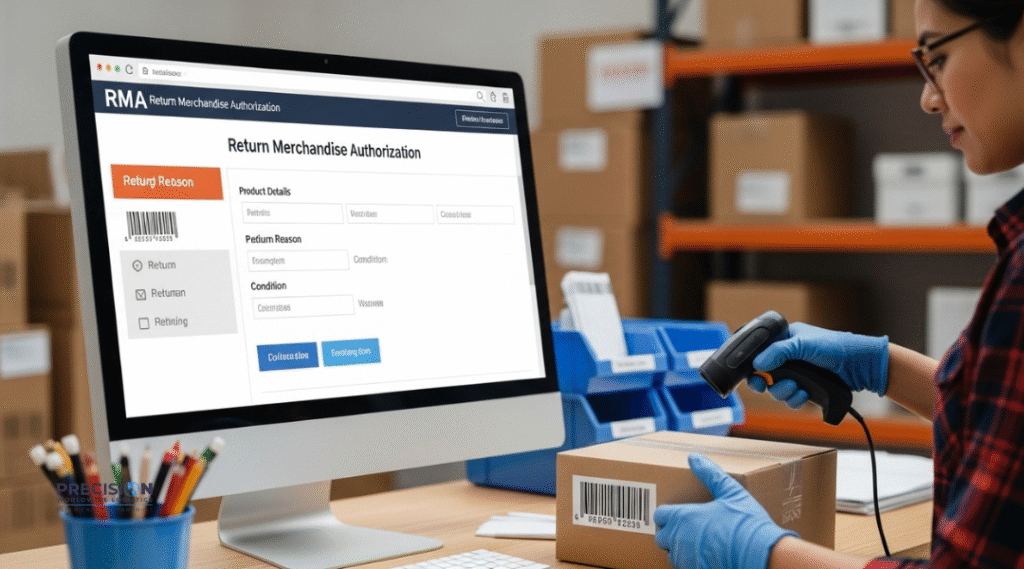
Precision Worldwide Logistics, Inc. focuses on an easy-to-use RMA system that provides clear instructions for customers and staff. The process captures essential information such as product details, reason for return, and condition. Automating approval workflows helps speed up decisions and avoids bottlenecks.
Clear communication during the RMA process also sets realistic expectations about timelines for inspection, refund, or replacement. This transparency improves customer relations and limits uncertainty in reverse logistics.
Centralized Returns Handling and Sorting
Centralizing returns handling allows Precision Worldwide Logistics, Inc. to consolidate resources and expertise at designated facilities. Returned products are inspected, sorted, and categorized efficiently based on condition and disposition requirements.
This approach reduces processing time and errors by using standardized checkpoints to determine whether items are restockable, repairable, recyclable, or disposable. It also improves inventory accuracy by tracking returns through barcode or RFID scanning.
Centralized sorting supports rapid decision-making for next steps, such as restocking, refurbishing, or liquidation, driving cost savings and enhancing asset recovery.
Integration with Forward Logistics and Inventory Systems
Integrating reverse logistics with forward supply chain and inventory systems is critical for end-to-end visibility. It enables live updates on returned goods, inventory reconciliation, and demand forecasting adjustments.
Precision Worldwide Logistics, Inc. employs software platforms that synchronize data across shipping, warehouse management, and order fulfillment systems. This reduces data silos and manual entry errors.
Real-time integration supports proactive inventory management by signaling when returned items can be reintroduced, preventing overstock or stockouts. It also provides actionable insights for continual process improvements in returns handling.
Technology and Tools That Improve Reverse Logistics
Efficient reverse logistics depends heavily on the use of specific technologies that enhance visibility, organization, and decision-making. Tracking mechanisms, advanced warehouse systems, and data analytics work together to reduce delays, control costs, and improve handling of returns.
Real-Time Tracking and Return Notifications
Real-time tracking allows companies to monitor returned goods from the moment they leave the customer until they reach the warehouse. This technology provides visibility into each return’s location and status, minimizing lost or delayed items.
Return notifications alert both the logistics team and the customer as items move through the reverse supply chain. This timely information improves communication and helps coordinate actions like inspections, refurbishments, or restocking.
With this transparency, companies reduce uncertainty, speed up processing, and improve customer satisfaction by keeping all parties informed consistently.
Warehouse Management Systems (WMS) for Returns
Warehouse Management Systems (WMS) tailored for returns support efficient sorting, inspection, and disposition of returned products. These systems organize returns according to condition, reason for return, and required next steps.
WMS software integrates with inventory control and order fulfillment to prevent overstocking and streamline the transfer of returned items back into sellable inventory or other processes like recycling.
This organization reduces handling errors, saves labor costs, and improves turnaround times in the warehouse. Integration with e-commerce platforms also automates return authorizations and documentation.
Data Analytics for Return Reasons and Process Optimization
Analyzing return data helps identify patterns such as frequent product defects, shipping damages, or customer dissatisfaction points. Businesses use this insight to target improvements in product design, packaging, or fulfillment practices.
Advanced analytics tools process large volumes of return information to forecast return rates and allocate resources accordingly. This predicts bottlenecks and supports proactive planning.
By continuously reviewing data, companies optimize reverse logistics workflows, reduce costs, and improve the overall returns experience for customers and partners.
Sustainability and Reverse Logistics
Effective reverse logistics directly influences environmental and economic outcomes. By optimizing returns management, companies reduce waste, conserve resources, and minimize carbon emissions. Integrating sustainable practices also highlights the value of refurbishment, recycling, and responding to market demands for greener logistics.
How Efficient Returns Reduce Waste and Carbon Footprint
Efficient handling of returns limits unnecessary disposal of products. When companies like Precision Worldwide Logistics, Inc. streamline their reverse flows, they decrease landfill contributions and resource waste.
Reducing transportation miles through consolidated returns cuts emissions. Improving sorting and inspection also ensures fewer items are discarded prematurely. This approach controls costs while addressing environmental impact.
Tracking return reasons helps identify product defects and packaging inefficiencies. Adjustments to these areas can further reduce the volume and frequency of returns, lowering the overall carbon footprint of the supply chain.
Refurbishing, Recycling, and Reselling Returned Goods
Returned items with functional parts or minor defects can be refurbished and resold, extending product life cycles. This restores value and reduces the demand for new raw materials.
Products that cannot be refurbished are often disassembled, with materials sorted for recycling. Precision Worldwide Logistics, Inc. supports processes that increase recovery rates while maintaining cost efficiency.
A clear categorization system enhances the speed and accuracy of reverse logistics operations. This ensures quality control for refurbished goods and maximizes the environmental benefits of recycling initiatives.
The Growing Demand for Green Logistics Solutions
Sustainability is now a critical factor in customer and regulatory expectations. Businesses must adopt reverse logistics technologies that promote transparency, efficiency, and environmental responsibility.
Software tools that monitor returns help identify excess waste areas, enabling targeted improvements. Companies investing in green logistics gain competitive advantages through cost savings and improved brand reputation.
Precision Worldwide Logistics, Inc. recognizes the importance of meeting this demand by integrating sustainable methods within its trucking and warehousing operations, contributing to a smaller ecological footprint.
How Precision Worldwide Logistics, Inc Helps Businesses With Returns Management
Precision Worldwide Logistics, Inc provides tailored logistics services designed to streamline every stage of returns management. Their approach combines specialized reverse logistics solutions with integrated transportation and warehousing to reduce costs and improve efficiency.
End-to-End Reverse Logistics Solutions
Precision Worldwide delivers comprehensive reverse logistics services that handle returns from initiation through final disposition. This includes inspection, sorting, refurbishment, recycling, or disposal based on product condition and client preferences.
They emphasize accuracy to minimize delays and errors that often increase costs. Their system tracks returns in real-time, giving clients clear visibility into status and location. This reduces processing times and accelerates inventory reintegration or disposal.
Precision Worldwide consults on customized returns workflows to meet unique operational needs. Their focus on precision supports improved customer satisfaction by ensuring faster, transparent returns handling.
Integration with Drayage, Trucking, and Warehousing
Precision’s full-service offering integrates drayage, trucking, and warehousing, allowing seamless movement of returned goods. Being located near the Port of Los Angeles supports swift handling of goods arriving or departing by sea.
Warehousing services include space optimization and inventory control with real-time tracking, which reduces handling errors during returns processing. Dedicated trucking and drayage units enable timely, controlled transport between fulfillment centers, warehouses, and client sites.
This connectivity minimizes handoffs, reduces turnaround times, and offers clients a single point of contact for complex logistics needs. It also helps lower transportation costs by coordinating deliveries and pickups efficiently.
Case Example: Reducing Return Processing Time for a California-Based Retailer
A California retailer faced challenges with slow returns processing, resulting in inventory delays and increased costs. Precision Worldwide implemented a tailored reverse logistics framework involving:
- Automated returns tracking
- Centralized inspection and sorting at their La Mirada warehouse
- Integrated trucking to move goods swiftly
Within three months, the retailer reduced return processing time by 35%. Real-time data visibility allowed proactive issue resolution, improving overall inventory accuracy and customer satisfaction.
This example highlights Precision Worldwide’s capability to enhance returns management through customized solutions and logistics integration.
Best Practices for Improving Your Reverse Logistics Process
Efficient reverse logistics requires clear policies, automation, and reliable partnerships. These elements work together to reduce costs, improve customer satisfaction, and simplify operations.
Set Clear Return Policies and Customer Instructions
Clear, concise return policies are critical to managing expectations and minimizing confusion. Return windows, conditions for acceptance, and restocking fees should be straightforward and easily accessible.
Providing customers with step-by-step instructions helps in reducing return errors. This can include how to prepare items for shipment and where to drop them off. Clarity here reduces delays and processing costs.
Consistent enforcement of policies ensures fairness and builds trust. It also helps employees handle returns uniformly, improving efficiency and customer experience.
Automate Where Possible: Labels, Tracking, and Refunds
Automation streamlines reverse logistics and reduces manual errors. Automated return labels can be emailed directly to customers, speeding up the return initiation process.
Tracking systems notify both the company and the customer about a return’s status in real time. This reduces inquiries and improves transparency.
Refund automation ensures that payments are processed quickly once returns meet policy requirements. Faster refunds enhance customer satisfaction and encourage repeat business.
Partner with a Specialized 3PL Like Precision Worldwide Logistics, Inc
Outsourcing reverse logistics to a specialized third-party logistics provider like Precision Worldwide Logistics, Inc allows companies to leverage expert handling and infrastructure.
Such partners offer tailored solutions for trucking, warehousing, and return processing, minimizing the burden on internal teams.
They also provide scalable services to adjust with business demand fluctuations, which helps control costs while maintaining service quality.
Working with a 3PL improves reverse logistics efficiency, freeing companies to focus on their core operations.

